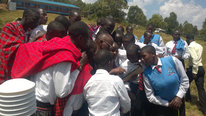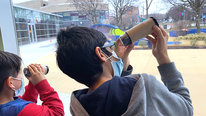- Molly Phillips
- https://www.idigtrio.org/
- iDigBio Education, Outreach, Diversity & Inclusion Coordinator
- Presenter’s NSFRESOURCECENTERS
- University of Florida, University of Florida
- Alnycea Blackwell
- Program Coordinator
- Presenter’s NSFRESOURCECENTERS
- iDigBio Univ of Florida
- Maria Duarte
- Assistant Director Academic Support
- Presenter’s NSFRESOURCECENTERS
- University of Florida
- Adania Flemming
- PhD Student
- Presenter’s NSFRESOURCECENTERS
- Florida Museum, University of Florida, iDigBio Univ of Florida
- Mary-Stuart Rice
- Academic Program Specialist TRIO SSS
- Presenter’s NSFRESOURCECENTERS
- University of Florida
iDigTRIO
2022 (see original presentation & discussion)
Grades 9-12, Undergraduate
The Mission of the iDigTRIO Biology Career Conference is to provide opportunities to explore careers and graduate programs in the biological sciences to first generation, limited income, and underrepresented students (Black, Latinx, Indigenous, other students of color, and students with disabilities). Through intentional programming and networking, we seek to support our future leaders in science and build a sense of community for their academic, personal, and professional journeys. As the name suggests, iDigTRIO is targeted to TRIO program students but all high school and undergraduate students are welcome.
iDigTRIO initially came from a collaboration among staff and students from the University of Florida Office of Academic Support, NSF supported iDigBio, and the Florida Museum (cofounders are Dekendrick Murray, Molly Phillips, and Adania Flemming). This is a completely free event taking place annually in February. The event includes career shadowing and mentoring, an opportunities fair, and a 3-day conference. Find out more information at our website: https://www.idigtrio.org/
Related Content for iDigTRIO Biology Career Conference
-
 2019iDigTrio: Biology Conference and Resource Fair
2019iDigTrio: Biology Conference and Resource Fair
Molly Phillips
-
 2021Bringing Out the Math in Making
2021Bringing Out the Math in Making
Andee Rubin
-
 2021Science Stories for Every Generation
2021Science Stories for Every Generation
Lorena Medina Luna
-
 2022From Moral Motives to STEM learning to STEM-informed action
2022From Moral Motives to STEM learning to STEM-informed action
Uduak Thomas
-
 2022NASA's Neurodiversity Network (N3)
2022NASA's Neurodiversity Network (N3)
Lynn Cominsky
-
 2021LabVenture Express: The Evolution of a Digital Field Trip
2021LabVenture Express: The Evolution of a Digital Field Trip
Leigh Peake
-
 2021Informal STEM Facilitator Training Program
2021Informal STEM Facilitator Training Program
Ron Skinner
-
 2017Using Industry Representatives to Increase Female Enrollment
2017Using Industry Representatives to Increase Female Enrollment
Katie Surra





Jay Labov
Currently STEM Education Consultant
Thank you for submitting this video. National biological collections initiatives offer a very rich avenue of career opportunities for people with a variety of interests in the biological sciences (for example, see the 2020 report from the National Academies of Sciences, Engineering, and Medicine, “Biological Collections: Ensuring Critical Research and Education for the 21st Century”). Establishing connections between this effort and TRIO is a very innovative approach to provide opportunity and access to careers in these fields to students from populations that historically have been vastly underrepresented in them. It also was interesting to see how interest in the career conference has expanded beyond initial efforts at the University of Florida.
Have your colleagues in other areas of the biological sciences (or STEM disciplines more generally) taken notice of your efforts and tried to replicate what you’ve done for their disciplines?
Molly Phillips
Justice Walker
Adania Flemming
PhD Student
Hello Jay,
Thanks for stopping by our poster. Great question.
To my knowledge, though folks have inquired about replicating our efforts this has not yet been fully realized. However, this may be influenced by the manner in which we organize around the topic "Biological Sciences". Given the intersecting or overlapping aspect with other disciplines we intentionally incorporate exploration and exposure to adjacent fields to Biology such as Paleontology, Bioinformatics, Anthropology, Archaeology, Librarianship (Science librarians) etc. This is strategically designed to expose students to varying career options. As a result inquiries usually result in partnering to help us accomplish or goals and missions, (particularly trying to reach our target audience) instead of replicating.
However, we are currently working on plans to expand iDiGTRIO to various locations within the US. We would be happy to chat about this if you are interested.
I hope this answers your question.
Molly Phillips
Justice Walker
Justice Walker
Assistant Professor
Congrats on what appears to be incredible success with your conference. I was especially interested in learning more about how you found that the three efforts coalesced well. In other words, what did each individual initiative contribute and how were those made stronger together. Also, I wondered if you had data on the demographic of attendee that has engaged with your program—does it match the groups you sought out to engage and has that shifted. As I learned more about the collaborations you are looking to forge to grow what seems to be an outstanding initiative, I thought I'd point you to a community bio initiative held at MIT: https://www.biosummit.org/. This organization is global and engages with open science, citizen bio and synthetic biology (i.e., DIY bio, biomaking, biodesign, etc.). This seems like a good complement or extension to the programs.
I hope to learn more about your efforts and how you designed them to work so well!
Molly Phillips
Adania Flemming
PhD Student
See responses in italices
Congrats on what appears to be incredible success with your conference. I was especially interested in learning more about how you found that the three efforts coalesced well. In other words, what did each individual initiative contribute and how were those made stronger together.
Hello Justice, Thank you. I believe you are asking about the three efforts in regard to the founders, Molly Dekendrick and myself. iDIgBio an NSF funded project to digitize natural history collections of which Molly is the Education, Outreach, Diversity and Inclusion Coordinator. In her role Molly seeks to broaden representation in STEM using collections. Dekendrick on the other hand as the TRIO director and staff member of the office of academic support worked closely with students who were marginalized in STEM, thus Dekendrick had connections to the audience Molly sought to engage. As a Black female graduate student and iDigBio research assistant while working in museums obtaining my masters degree realized the importance of experiences for these students in aiding gatekeeping in academia. Particularly from occupying spaces where I do not see myself represented . Thus, using the model of a course I created added the mentorship and shadowing component, which allows students to chat with various types of scientist about everything from their journeys to tips and tricks navigating certain careers to actually shadowing them in the field or lab to get hands on experience of the day to day components.
Also, I wondered if you had data on the demographic of attendee that has engaged with your program—does it match the groups you sought out to engage and has that shifted. As I learned more about the collaborations you are looking to forge to grow what seems to be an outstanding initiative, I thought I'd point you to a community bio initiative held at MIT: https://www.biosummit.org/. This organization is global and engages with open science, citizen bio and synthetic biology (i.e., DIY bio, biomaking, biodesign, etc.). This seems like a good complement or extension to the programs.
I hope to learn more about your efforts and how you designed them to work so well!
As far as demographics, we do have data that does match the audiences we are trying to engage, However the attendees have varied with the type of conference we host, whether virtual, hybrid or in person. Thus, we are continuously working on engaging folks who are most marginalized in STEM by building relationships with the communities around us. One component that helps us engage our attendees and helps spread the word is that the presenters and workshop host match the audience we hope to engage (Black, Indigenopus and other people of color, as well as other aspects such as, First-Generation, Limited Income and Students with a Documented Disability). Thus the Bio initiative at MIT is an appreciated suggestion. Congrats on your work.Check out our past presenters (idigtrio.org, https://www.idigtrio.org/2022-speakers, https://www.idigtrio.org/2021-speakers-facilitators)
I hope this answers your question, my colleagues can provide more insight. We look forward to connecting with you.
Molly Phillips
Molly Phillips
iDigBio Education, Outreach, Diversity & Inclusion Coordinator
All I have to add is that we would LOVE to connect with you Justice and learn more BioSummit and see how we could promote this in our work, or possibly collaborate!
Anne Kern
Professor
What do “iDig/iDig-Bio” stand for? TRIO programs are very important in facilitating access to Higher Education for underserved youth. Many of these programs, however, are totally underutilized by students that need or should seek out these programs. How did iDig-TRIO grow in attendance and conference participants more than double in three years? Many of the students recruited for the TRIO program appear to need summer and part-time jobs to both their families and potential college aspirations. How were you able to recruit students, were you able to “pay” them for their attendance and participation?
Molly Phillips
Adania Flemming
PhD Student
Hello Anne,
The iDig is from iDigBio which is an NSF funded project to digitize natural history collections. As you noted TRIO programs are important indeed and we have recognized some aspects of it being underutilized or sometimes not present in the schools with students who are most marginalized. As such the conference is open to students outside the TRIO programs. One of the aspects we continuously track is the diversity of our students along many axes including race/ethnicity, sex, ability etc. While we function to engage all students we are continuing to make partnerships to engage with our communities instead of simply providing outreach. This is one of the reasons we offer a mentorship and shadowing program as part of the conference, with the aim of connecting students to resources and hopefully opportunities beyond the conference. We do not pay students as the entire conference is free as is all the opportunities within. However, we have compensated the speakers/presenters who are mainly early or mid career scientists for their labor given they often present about their full selves beyond their science.
I hope this answers your question, my colleagues can provide more insight.
Further posting is closed as the event has ended.